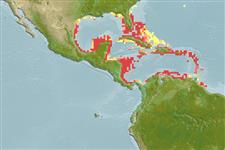Common names from other countries
Classification / Names / Names
Nomi Comuni | Sinonimi | Catalog of Fishes (gen., sp.) | ITIS | CoL | WoRMS
Environment: milieu / climate zone / depth range / distribution range
Ecologia
Associati a barriera corallina; distribuzione batimetrica 1 - 20 m (Ref. 116012). Tropical; 33°N - 8°N, 98°W - 50°W (Ref. 847)
Western Central Atlantic: Gulf of Mexico and Caribbean Sea.
Length at first maturity / Size / Peso / Age
Maturity: Lm ? range ? - ? cm Max length : 0.4 cm CORD maschio/sesso non determinato; (Ref. 847)
Colonies are thickets of pencil-thick branches. Corallites are widely spaced and up to 4 mm in diameter. Usually yellow.
Zooxanthellate (Ref. 116012). Found in shallow rock substrates (Ref. 847)
Life cycle and mating behavior
Maturità | Riproduzione | Deposizione | Uova | Fecundity | Larve
Members of the class Anthozoa are either gonochoric or hermaphroditic. Mature gametes are shed into the coelenteron and spawned through the mouth. Life cycle: The zygote develops into a planktonic planula larva. Metamorphosis begins with early morphogenesis of tentacles, septa and pharynx before larval settlement on the aboral end.
Bisby, F.A., M.A. Ruggiero, K.L. Wilson, M. Cachuela-Palacio, S.W. Kimani, Y.R. Roskov, A. Soulier-Perkins and J. van Hertum. 2005. (Ref. 19)
IUCN Red List Status (Ref. 130435)
CITES status (Ref. 108899)
Not Evaluated
Human uses
| FishSource |
Strumenti
Informazioni ulteriori
Age/SizeAccrescimentoLength-weightLength-lengthMorfologiaLarveAbbondanza
Fonti Internet
Estimates based on models
Preferred temperature
(Ref.
115969): 25.1 - 28, mean 26.9 (based on 142 cells).
Price category
Unknown.
